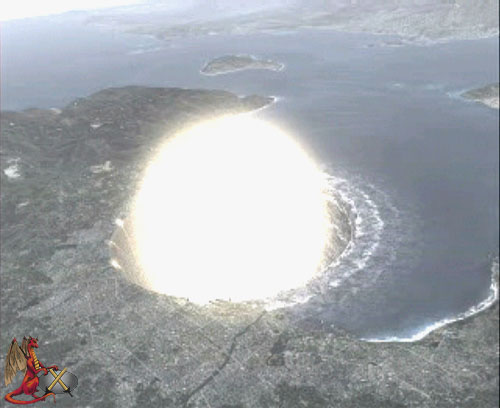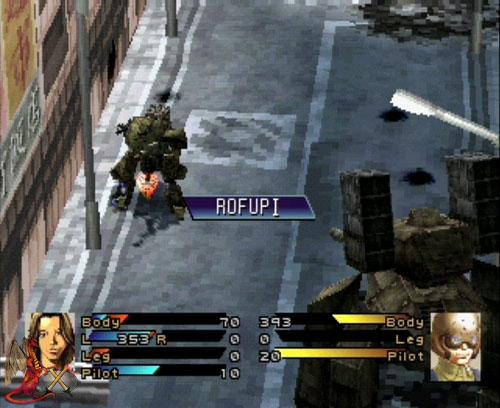|
|

|
PLATFORM
|
PSX
|
BATTLE SYSTEM
|

|
INTERACTION
|

|
ORIGINALITY
|

|
STORY
|

|
MUSIC & SOUND
|

|
VISUALS
|

|
CHALLENGE
|
Moderate
|
COMPLETION TIME
|
60-80 Hours
|
|
OVERALL

|
+ Unique Network system similar to in game encyclopedias in more recent games fills out the world.
+ Well balanced combat.
+ Near-future setting a welcome change from sword and sorcery
- Infuriatingly long
- Battles can depend too heavily on luck.
|
Click here for scoring definitions
|
|
|
Remember back in the day when the only way to explain was an SRPG to someone was to say "sort of like Final Fantasy Tactics?" And how half the people you said that to still didn't know what you meant? Well, like FFT, Square's Front Mission 3, while far from great is certainly a respectable game and helped clear a path for SRPGs in the American market. If a friend loses their job, gets married, or trades in their mother's basement for a smaller space of their own and offer you a chance to play an oldie, is the opportunity worth taking?
The first thing to say about Front Mission is that one has to give it credit for the complexity and detail of its world and plot. Admittedly, the translation is a bit dry at times, at least it is in retrospect, but there's a lot to respect about it. Front Mission 3 takes place more than a century in the future and has a detailed future history laid out, complete with shifted alliances and economic upturns and down turns. As an example, in the game Japan, along with Australia is a leading nation in the OCU- not at all dissimilar from the Greater Economic Co-Prosperity Sphere Japan tried to create during its imperialist phase, and their relations with such other major groups as the USN, comprised of both North and South America, are filled out in an impressive amount of detail for a video game. Any player willing to spend time poking around on the in-game Network, designed to simulate the internet will find all sorts of information about Front Mission's world, from realistically vague mission statements on company websites, to a century's worth of history in two pages on news websites, to university beauty contest pageants.
Unfortunately, the story is not as well planned out as the world itself, often bouncing back and forth in a needlessly confusing way. Why, pray tell, would people escaping from a country, safely out to sea on a submarine return and have to dramatically escape again? There's a reason, but it's far from satisfying. The storyline is impressively long- a first play through could take over seventy hours, but it doesn't end there. There are two separate paths through the game and the split comes almost at the very beginning. So if you enjoy the game, it offers a lot of bang for your buck. If you think it's merely okay or bland, it will seem to drag out to "infinity and beyond" so to speak.
 Don't worry, MIDAS is an "environmentally friendly" bomb.
Don't worry, MIDAS is an "environmentally friendly" bomb.
|
|
The short version runs like this- Kazuki Takemura is a college student and part time test pilot of wanzers, large humanoid robots, for Kirishima heavy industries, which among other things, is a manufacturer of wanzers. His father is a major player in the Japanese Defense Force and his adopted younger sister Alisa has recently been moved to a nearby military base as a research assistant. After the JDF's attempt to copy a USN made bomb results in an explosion, Kazuki and his best friend Ryogo who were delivering wanzers to the base, get sucked into a complex international power struggle and a conspiracy within the JDF which ultimately uses them as a scapegoat for the explosion. This accusation sends them fleeing the country either with the "Da Han Zhong"- the future name for China, or the USN which is comprised of North and South America, as they look to unravel the mystery of the MIDAS bomb, the various power struggles, and clear their name. Thanks to a new game plus mode, playing the entire game twice is a bit more feasible. It's still incredibly lengthy, which may or may not be a good thing.
FM3 runs on a straightforward system not dissimilar from that of the original Front Mission, released a few years back for the first time in America as Front Mission First for the DS. Most of the game is comprised of people talking at you for a while, then being forced into a lengthy fight. In other words, it's an SRPG. In towns, there tends to only be a few places to go- namely, the bars and the wanzer shops that sell you new weapons and upgrades. The player can also kill time reading about the world or strengthening themselves through practice battles over the Network.
In battle, movement is done on a typical grid. The height of terrain can drastically change accuracy and evade, and you will quickly learn to hate helicopters. Line of sight is also pivotal and not always sensible- on more than one occasion, I've seen situations where one combatant was able to take a clear shot, but objects in the way reduced the counter attack to almost nothing. Despite a few such random issues, it is done generally well and plays a significant part in battle as often times the fields are crowded with objects, destroyable and non-destroyable, from buildings to trees. As is common for SRPGs, characters can move and act once per round. How far they can move or what they can do, however, is dependant partially on Ace Points, or AP for short. In general, one space moved requires one AP and every weapon has an associated AP cost. For example, the moderately powerful, but highly accurate and extremely long ranged missiles cost 10 AP to use, while the short to midrange shotgun costs only 3. Flame throwers are incredibly powerful, but suffer from short range and eat up AP, making their users glass cannons as they may find themselves too short of AP to defend themselves or counter enemies, a truth driven home due to an AP penalty when counter attacking. AP regenerates at a static 12 per round for both players and enemies. Maximum AP can be increased by raising one's Ace Ranking, which is done by destroying the various parts of enemy tanks, helicopters, and of course, their humanoid wanzers.
 One of these days, generic enemy. Bang, zoom!
One of these days, generic enemy. Bang, zoom!
|
|
AP is also used as part of the customization of units. It is possible, as the game goes on, to purchase upgrades for a wanzer's HP, accuracy, movement, evade and defense. HP and movement upgrades work automatically, but the others only take effect if you're willing to assign AP to them. Choosing which things to upgrade and when is a part of your strategy, but take heart. Once you've purchased the upgrade, you can still take AP out of it if it isn't pulling its weight. Accuracy and evade upgrades work much as expected, and are automatic once AP is assigned. Movement and defense are a bit different. Movement effects a unit's booster and dash ratings. The booster is essentially how well the unit can jump, and can be used to hop atop buildings to take advantage of accuracy modifiers in or to take shortcuts across the battlefield. Dash allows a unit to move farther, and for less AP, but requires the unit to move in a straight line over level terrain. The defense upgrade is a bit unusual because a unit only gains a boost to defense against one of the three main classes of attacks- Pierce, Impact and Flame. Piercing defense is far and away the most valuable to the player, and is the attack type used by the well rounded Machine guns, and the weak, but long range rifles, as well as a few melee weapons. Impact covers the majority of melee weapons and the ever dangerous shotguns. Flame covers missiles, flamers, and the highly inaccurate, but powerful area of effect grenade launchers.
In addition to the upgrades, wanzers can be customized by swapping not only weapon types, but body parts. There are over thirty wanzer models, each with its own type of arms, legs, and main body. Those parts have different properties, so you may very well wind up with two different arms, one to carry your gun and be as accurate as possible, the other to carry a shield and be as tanky as possible. Each wanzer part also has an associated skill you can learn. The player has little control over when a skill is learned or used, as it largely relies on luck. Never the less, acquiring skills and using them well is your only major advantage in battle, since you will typically be outnumbered, outrun and outgunned. For instance, while Melee attacks are powerful, they only hit one wanzer part at a time, while Shotguns and Machine guns can hit them all, and melee priority is terrible, so that the attacker will be countered before they even move. Try equipping defensive skills like Fast Attack, which guarantees the first move and disables enemy counters, and avoid 80, which nulls any hit under 80 damage if it activates, and use a high activation computer to try and get them to work as often as possible. Or perhaps you have a mobile machine gunner and you want to turn them into a walking death machine. Equip them with as many copies of ROFUPI as you can stick into their computer's memory. Not only will ROFUPI increase the damage dealt by increasing your rate of fire in an exchange, it can easily combo into itself, allowing you to attack two or three times. What style you choose is up to you, but luck is a big factor, so you'll need to choose your skills carefully and not waste slots on junk or skills that you won't be able to activate with your current equipment.
Outside of battle, the game screams mediocrity. The sound effects are fine for the era and the music is okay, but redundant and unremarkable in the extreme. It will never be grating, but it's never exciting either. It's soundtracks like this that justify me keeping my CD player right next to my games. Visually, the game is a mix of bland and impressive. The normal graphics are presentable but unremarkable. As with many SRPGs, there's a cut to a sort of mini movie whenever a character makes an attack, and these can be pretty impressive, though simple. It's also got some incredibly stylish cinema scenes because, well, it's a Square game. Control is standard fare, with no glaring problems. It would be a real stretch to say anything- good or bad about any of the technical aspects of this game.
When all is said and done, is Front Mission 3 worth playing? Absolutely. Is it worth actually hunting down a copy? Probably not. It is, hands down, the best game in its series, and there are certainly worse fates than finding yourself in possession of this game. With solid, if heavily luck based combat, a fair amount of customization and a total length and (sometimes needless) complexity that makes it the War and Peace of SRPGs, it's worth a gander for anyone interested in what tactical games a decade ago thought the world a hundred years from now would be like.
Review Archives
|









